15 Natural Remedies for Fungal Skin Infections

Different kinds of fungi can cause a series of infections, which can lead to fungal skin infections. Among these fungi, we find dermatophytes and yeast. These infections colonize dead keratin, a protein found in the skin, nails, and hair.
They can appear in different areas of the body, show up in a range of forms, and, in general, cause symptoms like itchiness, redness, and scaly skin. Treatment depends on the type of fungus and the severity of the infection. However, according to this study from the Journal of Fungi, they’re usually treated with antimycotics.
There are also some natural remedies that use to treat these kinds of fungal skin infections. While they shouldn’t be a substitute for medical treatment, their application can help relieve symptoms. Ready to try them?
Causes of fungal skin infections
There are many types of fungi that can cause skin infections. However, there are some common triggers that tend to result in an overgrowth of fungus on the skin. These include:
- Weak immune system. The appearance of skin fungus indicates that your defenses are low because the body can’t fight them.
- Contagion. A common example is the showers at gyms or swimming pools. The fungus is on the damp floor, and from there enters and settles between the toes.
- Lack of hygiene and excess damp. These conditions increase the likelihood of colonization by different kinds of fungi. After washing, it’s important to dry your skin well between your toes and in all folds and creases of your body.
- Also, some people sweat more than others. This creates an ideal environment for these microorganisms to proliferate.
- Excessive sebaceous secretions.
- Poor diet and low vitamin intake. Not eating adequately makes the defenses drop. This makes it difficult to cleanse toxins.
- Stress. It’s widely known that stress lowers our defenses and, as we’ve mentioned, this makes it easier for fungi to reproduce.
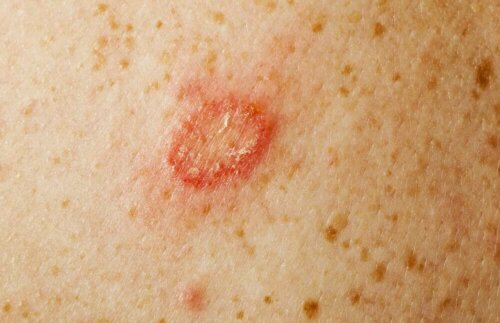
How to recognize a fungal skin infection
Symptoms vary, depending on what kinds of microorganisms are causing the infection. They’re sometimes also confused with other skin diseases. That’s why it’s important to see your doctor and get an accurate diagnosis.
The main clinical manifestations for a fungal skin infection are as follows:
- Spots or blemishes on the skin, which can be of different colors and sizes
- Reddish colored circles
- Itching or burning
- Bad odor
- Degradation of the skin
You may also be interested in: Learn How to Treat Foot Fungust With These Home Remedies
15 remedies to cure skin fungus
It’s very important to remember that fungal skin infections should be treated by a doctor or dermatologist. While there are some natural remedies that can alleviate your symptoms, you need medical treatment to get rid of the infection.
Additionally, you should remember that the evidence about the safety and effectiveness of some of these remedies is limited. Consequently, they may not always work how you expect them to. Nevertheless, if you’re interested in trying them, here are some options:
1. Diet
As a study from the American Journal of Clinical Nutrition found, nutrition is a determining factor in your body’s immune response. So, nutrients like zinc, selenium, iron, copper, vitamins A, C, E, B6, and folic acid play an important role in keeping your immune system healthy.
That means that if you want to prevent or treat fungal skin infections, you should focus on your diet. Make sure you include foods that provide these important nutrients. In general, experts recommend the following:
- Avoid red meats, white flour, sugar, and cow’s milk, as all these slow down your digestion.
- Eat more fruit (especially citrus fruits), vegetables, and whole grains. The juices help to increase our defenses and cleanse the body.

2. Natural yogurt
Studies show that probiotics play an important role in treating a fungal skin infection. A recent study published in the Journal of Microbiological Methods highlights that probiotics are useful antimicrobial and antimycotic agents.
- Yogurt, therefore, can help fight fungal infections because it contains lactobacillus, a beneficial bacteria that fights harmful microorganisms.
- You can also apply yogurt topically to the affected area and rub it in. This will help fight a fungal skin infection.
3. Lemon juice
There still isn’t enough evidence to support the ability of lemon to treat fungal skin infections. A study published in the International Journal of Molecular Sciences found that it could be useful for treating dermatophytosis in animals.
Despite this, it remains unknown if it’ll be effective against a fungal skin infection in humans. And, applying it topically can be irritating if you have sensitive skin. For that reason, it’s a remedy that you should use with caution, only at night. Exposing your skin to the sun after applying lemon juice can cause discoloration. The best way to reduce the risk is to dilute the juice in water.
4. Cranberry juice
Drinking cranberry juice can strengthen your immune system, which can help alleviate fungal skin infections. Among other things,a study published in Advances in Nutrition showed that cranberry juice can help strengthen your microbiota, which is crucial for strengthening your defenses.
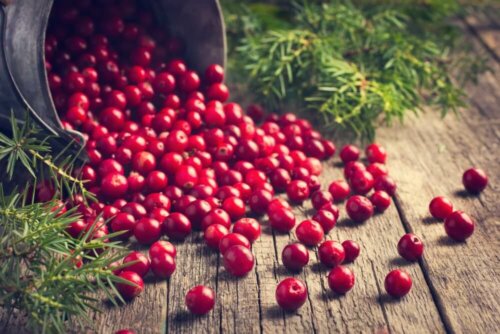
5. Tea for fungal skin infections
According to a study in Critical Reviews in Food Science and Nutrition, the tannins in tea can help inhibit the growth of many types of fungi, yeast, bacteria, and virus.
- Topically applying tea can help treat fungal skin infections, thanks to its antimycotic effects. It can also calm itching and burning. To get the best results, apply it to the area two or three times a day.
6. Olive leaf
Olive leaves can help you in two different ways. In addition to strengthening the immune system, they also have properties that help eliminate the fungus. This last part is what a study published in Current Medical Mycology notes; specifically, it has effects agiasnts Candida albicans.
To get the most from their benefits, you can:
- Drink cups of olive leaf tea (prepared with a tablespoon of leaves per glass of water)
- Apply it topically
7. Sea salt to fight a fungal skin infection
There’s no scientific evidence to support the use of sea salt as a natural antimycotic. However, alternative medicine often uses this ingredient for this purpose. If you want to try it, follow these instructions:
Ingredients
- 1 glass of water (2/5 pint)
- 2 tablespoons of sea salt (1 oz.)
What should you do?
- Add the salt to the glass of water, mix it well and then apply it topically several times a day.
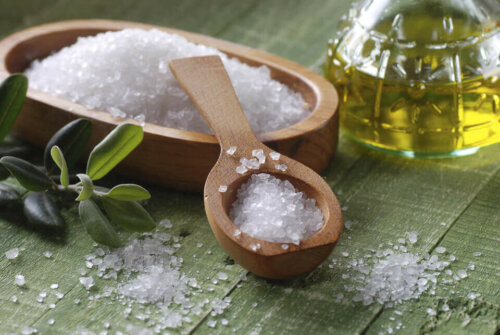
8. Garlic
Without a doubt, garlic is one of the most popular natural remedies for fungal skin infections thanks to its antifungal properties. In fact, a study published in the Iranian Journal of Basic Medical Sciences found that it could be an alternative treatment for dermatophytosis. Some ways to use it are as follows:
- Ingest it: a crushed clove of garlic; you can use it in a salad!
- Topically: mash a clove of garlic and put it on the affected area. Avoid using this if you have sensitive skin as it can irritate it.
9. Oregano oil
Oregano oil has some interesting potential medical uses. A study published in the International Journal of Current Microbiology and Applied Sciences (IJCMAS) found that it’s an effective antifungal ingredient. This makes it a good option for treating fungal skin infections.
- Ingesting it: two or three drops in a glass of water.
- Topically: mix equal parts of oregano oil and olive oil and apply it.
10. Using coconut oil against a fungal skin infection
The fatty acids in coconut oil can have important benefits for the skin. For example, a study published in the Journal of Medicinal Food suggests that it has antimicrobial and antifungal properties. So, you can use it to fight infections.
- To take advantage of its benefits, use it on the affected areas two or three times a day.
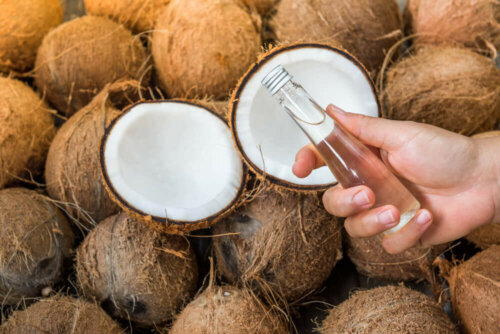
11. Apple cider vinegar
There isn’t enough scientific evidence to support the use of apple cider vinegar for fungal skin infections. However, studies suggest that it could be beneficial for these types of problems because of its acetic acid content.
Ingredients
- 2 tablespoons of water
- 1 tablespoon of apple cider vinegar
What should you do?
- Mix the two ingredients and apply them to the affected area with the help of gauze.
- You should avoid using this if you have sensitive skin or any open wounds as it can be irritating.
12. Tea tree oil for a fungal skin infection
Tea tree oil is a natural anti-fungal agent that also prevents the fungus from propagating to other areas of the body. A study published in Skin Pharmacology supports this claim and suggests that tea tree oil can even be helpful for problems like dandruff.
- Dilute it in water (3 to 5 drops), and apply it topically, massaging it into the affected area.
Keep reading: Vinegar as a Home Remedy for Dandruff
13. Turmeric
Turmeric has been recognized as a good natural antimycotic. This property seems to come from its high curcumin content. It can also be used in two ways:
- Locally: apply it to the affected area and leave it for a couple of hours, then rinse.
- Ingest it: take it as an infusion with milk and honey.
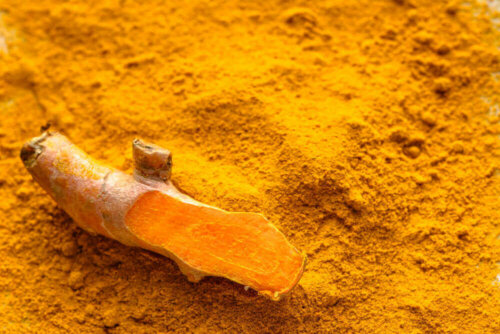
14. Colloidal silver
Scientific studies have suggested that colloidal silver has antimycotic properties that can help dry out the fungus. However, evidence about its safety and efficiency is still lacking.
- To use the extracts, follow the instructions of an herbal medicine practitioner.
15. Aloe vera to fight a fungal skin infection
Aloe vera has countless properties, including being antifungal. That is according to a study from the journal Fitoterapia, that found the said effect varies depending on the species of fungus.
- Cut the leaf and apply the gel inside onto the affected area several times a day.
Note: the success of these home remedies lies in applying them regularly, together with very good hygiene.
Overall. there are plenty of complementary remedies that could contribute to the treatment of fungal skin infections. However, it’s important to see your doctor or dermatologist to properly treat the problem.
All cited sources were thoroughly reviewed by our team to ensure their quality, reliability, currency, and validity. The bibliography of this article was considered reliable and of academic or scientific accuracy.
- Hay R. Therapy of Skin, Hair and Nail Fungal Infections. J Fungi (Basel). 2018;4(3):99. Published 2018 Aug 20. doi:10.3390/jof4030099
- Chandra, R. K. (1997). Nutrition and the immune system: An introduction. American Journal of Clinical Nutrition. American Society for Nutrition. https://doi.org/10.1093/ajcn/66.2.460S
- Kosgey, J. C., Jia, L., Fang, Y., Yang, J., Gao, L., Wang, J., … Zhang, F. (2019, July 1). Probiotics as antifungal agents: Experimental confirmation and future prospects. Journal of Microbiological Methods. Elsevier B.V. https://doi.org/10.1016/j.mimet.2019.05.001
- Dosoky NS, Setzer WN. Biological Activities and Safety of Citrus spp. Essential Oils. Int J Mol Sci. 2018;19(7):1966. Published 2018 Jul 5. doi:10.3390/ijms19071966
- Blumberg JB, Basu A, Krueger CG, et al. Impact of Cranberries on Gut Microbiota and Cardiometabolic Health: Proceedings of the Cranberry Health Research Conference 2015. Adv Nutr. 2016;7(4):759S–70S. Published 2016 Jul 15. doi:10.3945/an.116.012583
- Chung, K. T., Wong, T. Y., Wei, C. I., Huang, Y. W., & Lin, Y. (1998). Tannins and human health: A review. Critical Reviews in Food Science and Nutrition, 38(6), 421–464. https://doi.org/10.1080/10408699891274273
- Nasrollahi Z, Abolhasannezhad M. Evaluation of the antifungal activity of olive leaf aqueous extracts against Candida albicans PTCC-5027. Curr Med Mycol. 2015;1(4):37–39. doi:10.18869/acadpub.cmm.1.4.37
- Aala, F., Yusuf, U. K., Nulit, R., & Rezaie, S. (2014). Inhibitory effect of allicin and garlic extracts on growth of cultured hyphae. Iranian Journal of Basic Medical Sciences, 17(3), 150–154. https://doi.org/10.22038/ijbms.2014.2399
- Kocić-Tanackov, Sunčica & Dimić, Gordana & Tanackov, Ilija & Pejin, Dušanka & Mojović, Ljiljana & Pejin, Jelena. (2012). Antifungal activity of Oregano (Origanum vulgare L.) extract on the growth of Fusarium and Penicillium species isolated from food. Hemijska industrija. 66. 10.2298/HEMIND110614073K.
- Ogbolu, D. O., Oni, A. A., Daini, O. A., & Oloko, A. P. (2007). In vitro antimicrobial properties of coconut oil on Candida species in Ibadan, Nigeria. Journal of Medicinal Food, 10(2), 384–387. https://doi.org/10.1089/jmf.2006.1209
- Johnston CS, Gaas CA. Vinegar: medicinal uses and antiglycemic effect. MedGenMed. 2006;8(2):61. Published 2006 May 30.
- Hammer, K. A., Carson, C. F., & Riley, T. V. (2003). Antifungal activity of the components of Melaleuca alternifolia (tea tree) oil. Journal of Applied Microbiology, 95(4), 853–860. https://doi.org/10.1046/j.1365-2672.2003.02059.x
- Moghadamtousi SZ, Kadir HA, Hassandarvish P, Tajik H, Abubakar S, Zandi K. A review on antibacterial, antiviral, and antifungal activity of curcumin. Biomed Res Int. 2014;2014:186864. doi:10.1155/2014/186864
- Monteiro, D. R., Gorup, L. F., Silva, S., Negri, M., de Camargo, E. R., Oliveira, R., … Henriques, M. (2011). Silver colloidal nanoparticles: antifungal effect against adhered cells and biofilms of Candida albicans and Candida glabrata. Biofouling, 27(7), 711–719. https://doi.org/10.1080/08927014.2011.599101
- Rosca-Casian, O., Parvu, M., Vlase, L., & Tamas, M. (2007). Antifungal activity of Aloe vera leaves. Fitoterapia, 78(3), 219–222. https://doi.org/10.1016/j.fitote.2006.11.008
This text is provided for informational purposes only and does not replace consultation with a professional. If in doubt, consult your specialist.








